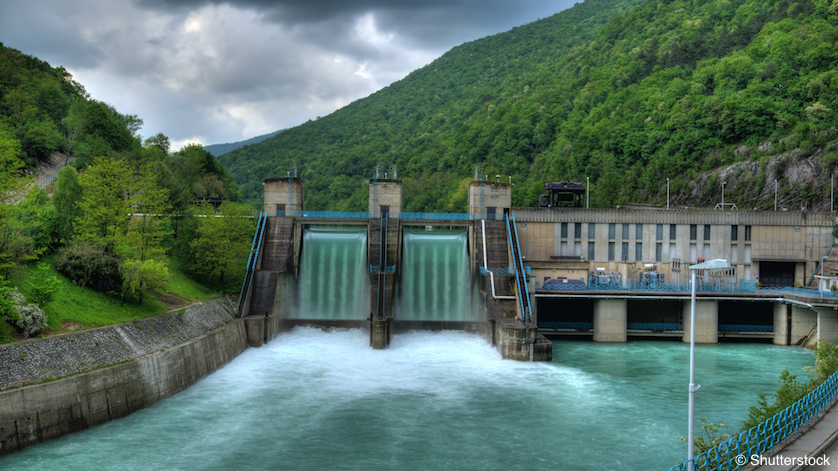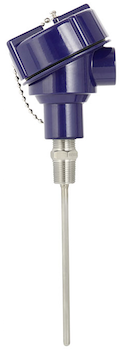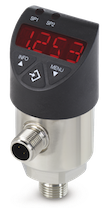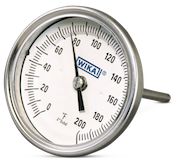
A hydroelectric power plant requires constant monitoring for it to operate safely and efficiently. Another essential is regular maintenance, which reduces unplanned downtime and lengthens a facility’s lifespan. WIKA has a comprehensive portfolio of high-quality instruments for measuring and monitoring pressure, flow, force, temperature, and level.
A hydropower plant is built to last decades, yet harsh conditions and normal wear and tear do take a toll on its various components:
- Turbines suffer abrasions from suspended solids.
- Metals are more prone to corrosion in the watery environment.
- High pressure, stress cycles, and water hammers often cause fatigue cracking.
- Partial load operations generate pulsating flows, turbulence, and cavitation.
- Unbalanced and misaligned shafts cause vibration and wear out bearings.
- Overheating can lead to deformation, metallurgical failure, and fires.
To keep the entire plant operating at peak efficiency and safety, engineers need to closely monitor and control a variety of parameters at numerous points.
What to Measure, Where to Measure, and What to Use for Measuring
In a process that relies so heavily on water, the two obvious considerations are water level and flow rate. However, today’s sophisticated hydroelectric plants also require regular monitoring of many other parameters, including temperature and pressure. Conditions vary from one spot to another within the plant, and the type of gauge or sensor needed depends on the particular point of measurement. In addition, instrumentation needs to be checked and calibrated regularly to make sure they continue to work within acceptable limits.
Here is a brief overview of what areas of a hydropower plant are measured, and the WIKA instruments that can be used for such measurements:

LF-1
1. Reservoir water level – how much potential energy is available in the reservoir and the hydrostatic pressure in the turbine. WIKA manufactures a complete line of submersible pressure transmitters for level measurement in rivers, lakes, and other bodies of water. LF-1, for example, is designed to withstand harsh operating conditions. Its extremely robust case is hermetically sealed and fully welded. The options of lightning protection, Hastelloy® construction, and FEP cables make it even more robust. For highly accurate readings, Model LF-1 can be integrated with temperature measurement to compensate for temperature fluctuations.

S-20
2. Flow and pressure at the penstock – to determine how much water will hit the turbines and at what rate. S-20 is a top-of-the-line, precision-engineered pressure transmitter. It features a piezoelectric sensor and thin-film technology and is highly resistant to pressure spikes and vibration. The S-20 has an all-welded stainless steel measuring cell inside a compact stainless steel case for added hardiness. A variety of available electrical and process connections meet the requirements of almost any application.
3. Differential pressure in the filtering system – to evaluate how clean or clogged the filter is. SP007 is a completely customer-configurable pressure transducer. It has a standard accuracy of 0.25% and an optional high accuracy of 0.1%. Model SP007 can accurately measure the difference in pressure between the two sides of the filter, which gives a good indication of the cleanness of the filter. Users have a choice of 6 pressure ports, 5 electrical connections, and a voltage or current output to match the needs of their applications.

23X.54 with InSight glow-in-the-dark dial
4. Pressure at the turbine – to indicate whether the turbine is full or empty, and if it is ready to start or needs to be shut down. The 23X.54 is a stainless steel industrial Bourdon tube pressure gauge with bayonet bezel ring. It has been specifically designed to work extremely well in applications subjected to high dynamic pulsations and vibration. Model 23X.54 can measure pressures up to 15,000 psi. It can be outfitted with WIKA’s InSight glow-in-the-dark and reflective dials for better readability in poor light and visibility conditions.

TR10-3
5. Oil and metal temperatures of the bearings in turbines, generators, and other systems – to identify the hot spots and overheating that can lead to increased wear and tear. The TR10 and TR40 resistance thermometers are ideal for measuring temperature in bearings and bushings, oil and water tanks, air tanks, and heat exchangers.
The TR10 series of RTD sensors can be mounted into a thermowell, or directly into the process with a spring-loaded compression fitting for easy installation and replacement. TR10 RTDs can come with a transmitter to convert the resistance signal into an analog or a digital output, which can be easily customized to a variety of conditions. The TR40 series of cable resistant thermometers is designed for high performance in a wide range of temperatures: from −320°F to +1,112°F (−196°C to +600°C). Choose from a tubular or sheathed design, and from 2-, 3-, or 4-wire configuration. A variety of cable materials – PVC, silicone, PTFE, glass fiber – ensure that the TR40 meets the requirements of most applications. Both the TR10 and the TR40 series are available in explosion-protected versions.
The TR58 bearing RTD sensor is small, compact, and has been designed for areas where space is an issue. It uses thin-film technology and responds extremely fast. With no moving parts, it is vibration resistant and perfect for measuring temperature in thrust bearing plates, shafts, and motor windings. The TR58 can be spring loaded into the bearings’ housing or held in position with a high-temperature epoxy resin.
6. Flow, temperature, and pressure of fluids in the cooling systems

PSD-4
7. Lubricant level and pressure of hydraulic systems and turbines – WIKA’s electronic pressure switch PSD-4, the updated version of the award-winning PSD-30, is the component of choice for measuring pressure in bearings and bushings, oil and oil pump control circuits, air tanks, and suction pipes. It is recognized for its robustness, user-friendly construction, and exceptional functionality. A large display and simple navigation menu make setup fast and intuitive. Large ergonomic keys allow for easy adjustments. The PSD-4 is easy to mount in almost any configuration.
8. Temperature near the endcaps of the stator winding and at the transformer nucleus in the generator – to avoid hot spots, overheating, and fires.
9. Air pressure at the generators’ ventilation circuits – to ensure proper cooling. Hydropower plants routinely choose WIKA’s differential pressure switch A2G-40 to monitor flow in air filters, fans, cold air circuits, and ventilation ducts. The compact switch is very easy to assemble and install. The robust A2G-40 can operate at ambient temperatures between −40°F and +185°F (−40°C to +85°C), and medium temperatures between −20°F and +160°F (−29°C to +75°C).

TI.30
10. Temperature at the bus bars and thyristor bridges in the high voltage area – to prevent fires. TI.30 is a completely stainless steel bimetal thermometer specifically designed for temperature measurements in harsh and aggressive environments. Liquid dampening makes it perfectly suitable for high vibration applications. It has an accuracy of 1.0% FS and can measure temperatures from -100°F to (-73°C) to + 1000°F (+538°C).
In addition, WIKA offers a wide range of valves, valve manifolds, and monoflanges for shut-off, venting, and compensating functions. These accessories separate instrumentation from the process and allow problem-free recalibration and replacement of the instrument. A variety of sizes, brackets for wall and pipe mounting, and connection types – including NPT and G (metric) connections – make installation easy. WIKA also manufactures siphons, snubbers, overpressure protectors, and a complete line of diaphragm seals to further protect the integrity of the instrument and of the process.
WIKA Instruments in Hydropower Plants
WIKA is known throughout the hydropower world for high-quality instruments when measuring temperature, pressure, level, flow, and force. Here are some of the projects where WIKA products have been utilized:
China
WIKA has manufactured pressure, temperature, and level instrumentation for more than 20 hydropower plants in China. This includes 2,200 units for the Three Gorges Dam station, the largest hydroelectric plant in the world (22.5 GW capacity), and 1,130 units for the Xiluodo station, the third largest (13.86 GW capacity) in the world.
Brazil
WIKA’s measuring instruments are found in the Jirau and Santo Antonio hydroelectric plants on the Madeira River in Brazil’s Porto Velho area. Our experts worked hand in hand with the contractors of these two large hydroelectric plants (3,750 MW and 3,150 MW, respectively) to design and manufacture the components that best fit their requirements. For these plants, WIKA developed special parts and supplied more than 4,600 units, including:
- 717 PSD-30 electronic pressure switches for measuring oil pressure at the oil and oil pump controlling circuit, oil pressure in the bushings, and pressure at the suction pump.
- 464 A2G-40 differential pressure switches for monitoring air pressure in the generator’s ventilation circuit.
- 56 Cella pressure switches
- 756 pressure gauges
- 2,096 TR10/TR40 temperature sensors for monitoring the temperature of air, heat exchange, and oil in bushings and oil tanks.
- 180 TR70 temperature switches
- 112 Cella temperature switches
- 212 temperature gauges
- 28 level gauges
Contact our power generation specialists for more information on WIKA’s one-stop-shop solutions for power plants.
Don’t miss the final article in this 3-part series: The Importance of Calibration and Force Measurement in Hydropower Plants.


The article emphasizes the importance of continually monitoring various parameters like water level, flow rate, pressure, temperature, and vibration to optimize performance and detect potential issues early.